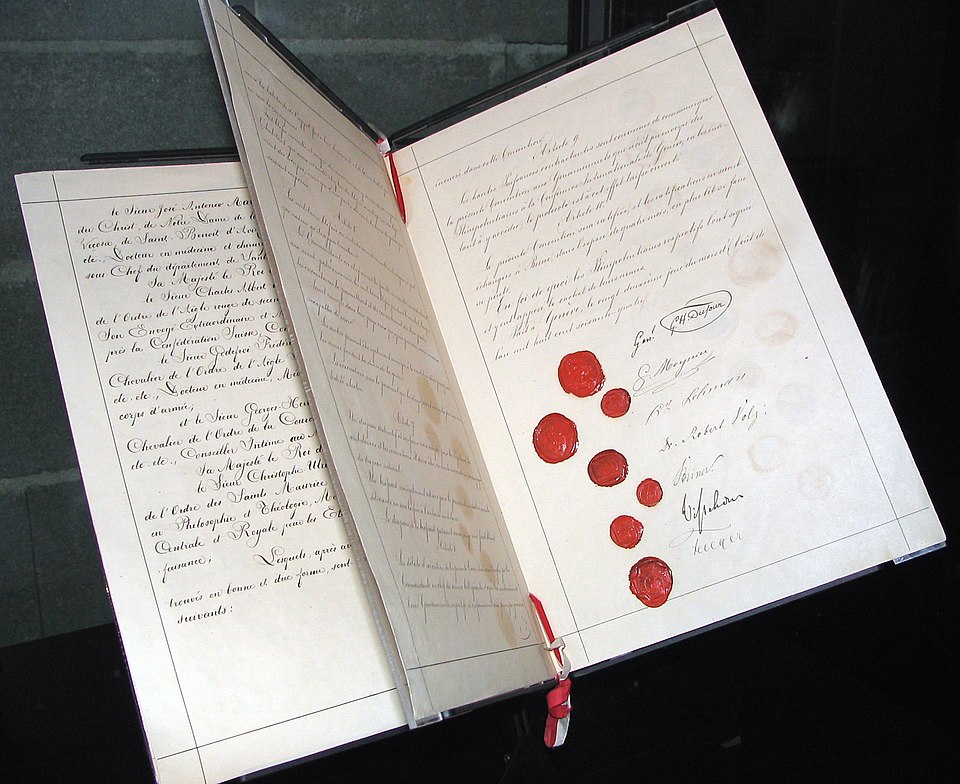
What is the Geneva Convention? The Geneva Convention is actually the Geneva Conventions because there are more than one. It is a set of four treaties that lay out the humanitarian rules of war. There were four meetings, held in 1864, 1906, 1929, and 1949. Both of them came after a major war, when people thought that something needed to be done.
The idea behind the Geneva Conventions was to protect all of the people who were affected by the war but were not fighting. These were civilians, medics, aid workers, wounded people, sick people, shipwrecked people, and prisoners of war. War has always existed, and civilians were very often just considered the spoils of war. If a town or a city were overrun, the people would usually become slaves of the victors. To the victors, the spoils of war, and all that. However, through the 19th century, with the invention of more powerful weapons, wars were becoming more brutal. Despite that, there was almost always a battlefield, which was generally away from civilians. There were also no medics. When we entered the twentieth century, warfare changed significantly. Weapons became so powerful that tactics changed, and the new guns and mortars could very easily reach civilian locations. Vastly more soldiers were injured on the battlefield, necessitating a huge force of medics to go onto the battlefields to try to help them. Far more prisoners of war were captured than ever before. And, perhaps worse than that, the new form of warfare could reach into civilian life. The First World War destroyed towns and cities, but nothing on the scale of the Second World War. Rules needed to be thought up.
The idea behind a set of rules came about largely thanks to Henry Dunant and his new Red Cross. He was in Italy during one of Napoleon’s battles, and he saw that all of the wounded soldiers were basically left on the battlefield to die. This spurred him to make the International Red Cross. The first Geneva Convention was in 1864 and was aimed at working out rules to help the sick and wounded soldiers who were left on a battlefield. The convention was attended by 12 countries. Four of those kingdoms don’t exist anymore. It was not an international treaty by any stretch of the imagination. However, it was a step in the right direction, and the treaty called for neutral status for the Red Cross and protection for medical people and volunteers trying to help the wounded.
The next meeting was in 1906. 35 countries attended a meeting held in Geneva again. This meeting was again to set rules for the treatment of wounded and sick soldiers on the battlefield. This was followed by a meeting in 1929, which came after the end of World War 1. That war had shown that wounded soldiers and prisoners of war were still not being treated properly. The 1929 convention adopted two treaties to cover these points. One for the treatment of wounded soldiers and one for the treatment of prisoners of war. These treaties were signed by 46 countries. It seemed like a positive move, and then World War 2 happened.
People thought World War 1 was bad, but World War 2 was on a whole new level, not just with the number of combatants killed and injured, but with the number of civilians killed and injured, and the number of atrocities, such as the Holocaust and the treatment of prisoners of war. People were sick of war, and there was a strong will to make sure nothing like that could happen again. The meeting was held in Geneva in 194,9 and it modernized the first two Conventions that had been ratified in 1929 and added two more. It was signed by 196 countries.
So, what are the four Geneva Conventions? The First Geneva Convention is for the amelioration of the condition of the wounded and sick in armed forces in the field. (Amelioration means the act of making something better.) This one protects the wounded and all who are trying to help them. It also stipulates that both sides must look for and aid the wounded after the battle. The Second Geneva Convention is the same as the First, but it is for wounded and sick combatants at sea. The Third Geneva Convention is relative to the treatment of prisoners of war. Prisoners of war must be treated humanely, given adequate food, and medical care. You can tell that this was made after World War two because one of the articles says, “prisoners of war must not be subjected to torture or medical experimentation.” It also has the famous article that we have seen in a lot of war movies. “Prisoners of war are required to provide to their captors only their name, rank, date of birth, and military service number.” And the Fourth Geneva Convention is relative to the protection of civilian persons in time of war. This says that civilians are to be treated humanely and looked after. And this is what I learned today.
Sources
https://www.icrc.org/en/law-and-policy/geneva-conventions-and-their-commentaries
https://en.wikipedia.org/wiki/Geneva_Conventions
https://www.law.cornell.edu/wex/geneva_conventions_and_their_additional_protocols
https://ihl-databases.icrc.org/en/ihl-treaties/gc-pow-1929/state-parties
Image By Kevin Quinn, Ohio, US – Flickr, CC BY 2.0, https://commons.wikimedia.org/w/index.php?curid=359407

